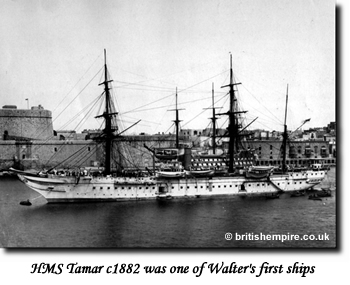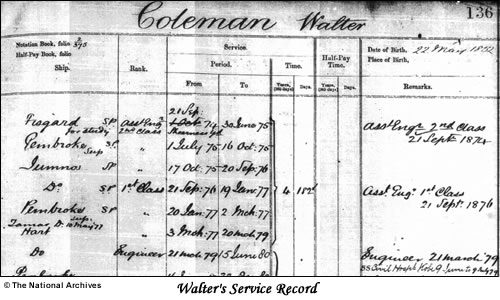This was just about the only thing which we knew about my great x2 uncle, Walter Coleman. He was part of my dad’s family, and a long letter written to Dad in the 1980s by his cousin gave lots of details about the family, including the above little snippet about their great uncle who had died before they were born.
It was just the sort of thing to get my dad interested in family history!
When I began researching our family in the 1990s there was not much available online, but one valuable resource was the 1881 census transcription. I had a merry time looking for everyone I could think of and eventually looked for and found Walter.
He was serving aboard ‘HMS Hector’, which was moored off Hampshire. He was described as an ‘Engineer (Naval Officer)’. This perked my dad up even more because he too had a career in engineering, British Railways in his case.
When the 1901 census became available we found Walter again. This time he was lodging in Barrow in Furness (then in Lancashire), a town with a proud history of building naval ships. Walter was now a fleet engineer. That sounded important and it looked as if he really had ‘done well in his naval career’.

My dad was now keen to find out more and, for an 83rd birthday treat, my brother took him to London and they spent the day at The National Archives in Kew. They found Walter’s complete naval service record and also records of certificates he had passed during his career. Dad was also able to find out what type of ships Walter had served on.
Walter Coleman was born in Ampthill, Bedfordshire, on 22nd May 1852. He was the eleventh of the twelve children of Edward Coleman and his wife Ann.

The Coleman family can be traced in Ampthill from 1693 and during that time they had been, firstly, leather sellers and cordwainers, and had later turned to wholesale grocery and had become a fairly prosperous family. All the other branches of this family are from Bedfordshire as far back as I can trace them. In other words they are a very ‘landlocked’ family, far from the sea and with no interest whatsoever in engineering!
What was it that sparked Walter’s interest? While he was still a child he must have read about the new types of ship just entering service; ships that didn’t rely on sails but had steam engines and propellers. These were large ‘ironclad’ ships and must have seemed exciting to young Walter. Did he have to work at persuading his father to allow him to start as an engineering student at Sheerness in Kent, when he was only 15? Or perhaps Edward was only too pleased to have one less grocer to find work for!
The service record that Dad copied at The National Archives only begins when Walter had passed his first exams and become ‘Assistant Engineer 2nd Class’ in 1874. He had started in Sheerness as an engineering student on 25th February 1868 and qualified on 21st September 1874. I assume that this is equivalent to an apprenticeship in civilian life and that Walter’s father would have had to contribute towards his keep.
The service record goes on to list all the ships and periods of study during Walter’s entire career. It finishes with his retirement on 5th August 1908 and his retired pay of £550 per year. It even notes the date of his death in 1914 and that probate of his will was given to his wife Elizabeth.
Interpreting the service record takes some time. The first column is the list of ships and it takes a while to realise that some names are those of shore training bases. They are either ships permanently in harbour or land buildings. ‘HMS Pembroke’ occurs at intervals throughout Walter’s service. It was a naval barracks at Chatham Dockyard.

The second column lists the rank attained at each stage. Walter began as an ‘Assistant Engineer 2nd Class’ and progressed to an ‘Engineer’, a ‘Chief Engineer’, a ‘Staff Engineer’, an ‘Engineer Commander’ and finally an ‘Engineer Captain’ in the last years of his service.
The service column lists the dates of start and end of each period and also makes a running list of his total time in the Royal Navy.
The final column is ‘Remarks’ which has jottings about various certificates passed, a spell in hospital in the Far East and ships travelled on to postings, mainly in China and the Far East.
Walter’s naval career covered a period of great change but also of great stability in the Royal Navy. When he entered the Navy, most ships still had sails in case their newfangled engines failed. By the time he left the huge battleships used in WWI were being launched. The launching and fitting out of ‘HMS Vengeance’, a 12,950 ton battleship, was the reason for Walter being in Barrow in Furness at the time of the 1901 census. He saw the change from coal steam powered ships to those powered with oil fuel turbines and was an oil fuel instructor when he retired. The Navy was strong and powerful but during the whole of his career there were no major wars. He died just as WW1 was starting, so never knew the full horror of world conflict.
Walter Coleman brought family history to life for my dad, and gave him a huge amount of pleasure in researching his service and finding all the details of the ships he had served on. Dad died in 2006, but I still have all his notes about Walter and his ships.
Anne in Carlisle
© Anne in Carlisle 2008
1. You can now search for and download Royal Naval Officers’ Service Records from TNA at a cost of £3.50. I have not bought Walter’s since I already have them but I have found his name in the index.
2. If you are searching for an engineer in the RN you need to bear in mind that engineers only became commissioned officers in the Navy in 1847. Before this they were warrant officers.
